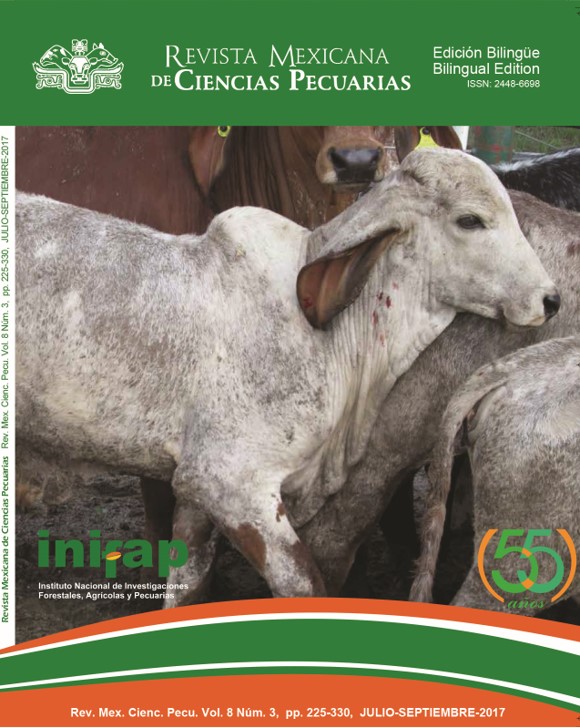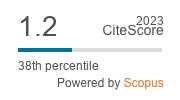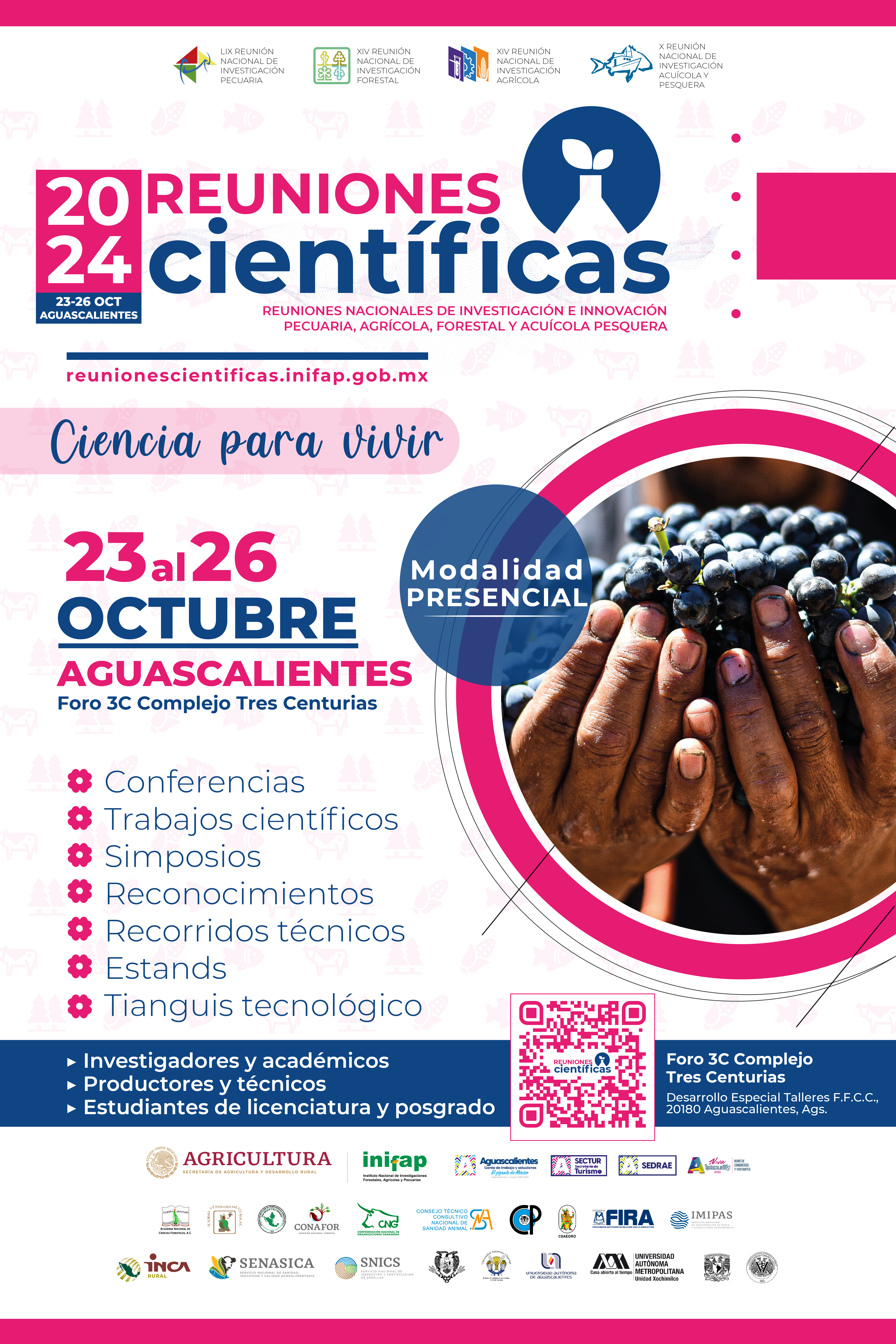El nematodo Caenorhabditis elegans como modelo para evaluar el potencial antihelmíntico de extractos de plantas
DOI:
https://doi.org/10.22319/rmcp.v8i3.4504Palabras clave:
Resistencia, Antihelmínticos, Caenorhabditis elegans, Extractos de plantas, Conocimiento tradicional.Resumen
Los nematodos parásitos afectan la productividad pecuaria, dando lugar a pérdidas económicas considerables. Sin embargo, son pocos los antihelmínticos disponibles en el mercado y la resistencia de los parásitos a los existentes va en incremento, por lo que su control es actualmente ineficiente. En este sentido, la búsqueda de nuevas estrategias para controlar la parasitosis es una necesidad actual. Una posibilidad para el control estriba en la investigación de metabolitos derivados de plantas, ya que el conocimiento sobre su uso tradicional es un referente de inicio. Sin embargo, la eficacia antihelmíntica, así como los mecanismos de acción de plantas con uso tradicional como anti-parasitarios, poco se han investigado científicamente, y en la mayoría de los casos se desconocen los compuestos activos responsables del efecto anti-parasitario. Una de las limitantes del estudio experimental del potencial antihelmíntico es la dificultad de trabajar con modelos parásitos. En este sentido, el nematodo de vida libre C. elegans es un modelo útil para entender el mecanismo de acción de drogas antihelmínticas. Por un lado, este nematodo se puede mantener y manipular en laboratorio con facilidad; por otro, comparte características fisiológicas y homología genética con nematodos parásitos, lo que permite comparaciones válidas. En esta revisión se pretende mostrar el potencial de la búsqueda de compuestos activos derivados de plantas tradicionalmente utilizadas como anti-parasitarios como punto de partida en el desarrollo de nuevos fármacos antihelmínticos, así como resaltar las ventajas que C. elegans proporciona para entender los mecanismos de acción de nuevos compuestos.
Descargas
Citas
Hotez PJ, Brindley PJ, Bethony JM, King CH, Pearce EJ, Jacobson J. Helminth infections: the great tropical diseases. J Clin Invest 2008;118 (4):1311-1321.
Papadopoulos E, Gallidis E, Ptochos S. Anthelmintic resistance in sheep in Europe: A selected review. Vet Parasitology 2012;189(1):85-88.
Kaminsky R, Gauvry N, Schorderet WS, Skripsky T, Bouvier J, Wenger A, et al. Identification of the amino-acetonitrile derivative monepantel (AAD 1566) as a new anthelmintic drug development candidate. Parasitol Res 2008;103(4):931–939.
Kaplan RM. Drug resistance in nematodes of veterinary importance: a status report. Trends Parasitol 2004;20(10):477-481.
Geary TG, Chibale K, Abegaz B, Andrae-Marobela K, Ubalijoro E. A new approach for anthelmintic discovery for humans. Trends Parasitol 2012;28(5):176-181.
Martin M, Mathias E, McCorkle CM. Ethnoveterinary Medicine: An annotated bibliography of community animal healthcare. 1rst ed. London, UK: ITDG Publising; 2001.
Bizimana N. Introduction. In: Traditional veterinary practice in Africa. 1rst ed. Rossdorf, Germany: Deutsche Gesellschaft fur Technische Zusammenarbeit (GTZ); 1994:8-13.
McGraw LJ, Eloff JN: Methods for evaluating efficacy of ethnoveterinary medicinal. In: Katerere, DR, Luseba D editors. Ethnoveterinary botanical medicine. 1rst ed. USA: Taylor and Francis Group; 2010:1-24.
Waller PJ, Bernes G, Thamsborg SM, Sukura A, Richter SH, Ingebrigtsen K, et al. Plants as de-worming agents of livestock in the Nordic countries: historical perspective, popular beliefs and prospects for the future. Acta Vet Scand 2001;42:31-44.
Saika B, Borthakur SK. Use of medicinal plants in animal healthcare-A case study from Gohpur, Assam. Indian J Trad Knowledge 2010;9(1):49-51.
Tariq KA, Tantry MA. Preliminary studies on plants with anthelmintic properties in Kashmir-The north-west temperate Himalayan region of India. Chinese Medicine 2012;3:106-112.
Akhtar MS, Iqbal Z, Khan MN, Lateef M. Anthelmintic activity of medicinal plants with particular reference to their use in animals in the Indo-Pakistan subcontinent. Small Ruminant Res 2000;38(2):99–107.
Jain P, Singh S, Sandeep K, Verma SK, Kharya MD, Solanki S. Review: Anthelmintic potential of herbal drugs. International J Res Develop Pharmacy Life Sci 2013;2(3):412-427.
Prichard RK. Anthelmintic resistance. Vet Parasitol 1994;54(1-3):259-268.
Hoste H, Jackson F, Athanasiadou S, Thamsborg SM, Hoskin SO. The effects of tannin-rich plants on parasitic nematodes in ruminants. Trends Parasitol 2006;22(6):253–261.
Lanusse CE, Prichard RK. Relationship between pharmacological properties and clinical efficacy of ruminant anthelmintics. Vet Parasitol 1993;49(2-4):123-158.
Mottier L, Lanusse C. Bases moleculares de la resistencia a fármacos antihelmínticos. Rev Med Vet 2001;82(2):74-85.
Wink M. Medicinal plants: a source of anti-parasitic secondary metabolites. Molecules 2012;17(11):12771-12791.
Márquez LD. El desarrollo de nuevos antiparasitarios. En: Resistencia a los antihelmínticos en nematodos de rumiantes y estrategias para su control. 1rst ed. Colombia: Corpoica y Colciencias; 2007:24-25.
Fenwick A, Webster JP. Schistosomiasis: challenges for control, treatment and drug resistance. Curr Opin Infect Dis 2006;19(6):577–582.
McCarthy J. Is anthelmintic resistance a threat to the program to eliminate lymphatic filariasis? Am J Trop Med Hyg 2005;73(2):232–233.
Vercruysse J, Albonico M, Behnke JM, Kotze AC, Prichard RK. Is anthelmintic resistance a concern for the control of human soil-transmitted helminths? Int J Parasitol Drugs Drug Resist 2011;1(1):14–27.
Osei-Atweneboana MY, Awadzi K, Attah SK, Boakya DA, Gyapong JO, Prichard RK. Phenotypic evidence of emerging ivermectin resistance in Onchocerca volvulus. PLoS Negl Trop 2011;5:99-89.
WHO. World Health Organization. Accelerating work to overcome the global impact of neglected tropical diseases: a Roadmap for Implementation. Francia: WHO Press, 2012.
Jabbar A, Iqbal Z, Kerboeuf D, Muhammad G, Khan MN, Afaq M. Anthelmintic resistance: the state of play revisited. Life Sci 2006;79(26):2413-2431.
Prichard RK, Hall CA, Kelly JD, Martin CA, Donald DA. The problem of anthelmintic resistance in nematodes. Aust Vet J 1980;56(5):239-251.
Márquez DL. Resistencia a los antihelmínticos: origen, desarrollo y control. Revista Corpoica 2003;4(1):55-57.
Drudge JH, Leland SEJ, Wyant ZN. Strain variation in the response of sheep nematodes to the action of phenothiazine: II. Studies on pure infections of Haemonchus contortus. Am J Vet Res 1957;18(67):317–325.
Reinemeyer CR. Diagnosis and control of anthelmintic-resistant Parascaris equorum. Parasit Vectors 2009;2(Suppl 2):1-6.
Craig TM. Anthelmintic resistance and alternative control methods. Vet Clin North Am Food Anim Pract 2006;22(3):567-581.
Waller PJ, Prichard RK. Drug resistance in nematodes. In: Campbell y Rew editors. Chemotherapy of parasitic. 1rst ed. New York, USA: Plenum Press; 1986:339-362.
Prichard RK. Anthelmintic resistance in nematodes: extent, recent understanding and future directions for control and research. Int J Parasitol 1990;20:515–523.
Kaplan RM. Biology and management of anthelmintic resistance. In: Elsheikha HM, Khan NA editors. Essentials of veterinary parasitology. 1rst ed. Norfolk, UK: Caister Academic Press; 2011:201-204.
Waller PJ. International approaches to the concept of integrated control of nematode parasites of livestock. Int J Parasitol 1999;29(1):155–164.
Eddi C, Caracostantogolo J, Peña M, Schapiro J, Marangunich L, Waller PJ et al. The prevalence of anthelmintic resistance in nematode parasites of sheep in southern Latin America: Argentina. Vet Parasitol 1996;62(3-4):189-197.
Requejo-Fernandez JA, Martinez A, Meana A, Rojo-Vazquez FA, Osoro K, Ortega-Mora LM. Anthelmintic resistance in nematode parasites from goats in Spain. Vet Parasitology 1997;73(1):83-88.
Roeber F, Jex AR, Gasser RB. Impact of gastrointestinal parasitic nematodes of sheep, and the role of advanced molecular tools for exploring epidemiology and drug resistance-an australian perspective. Parasit Vectors 2013;6:153.
Van den Brom RL, Moll FH, Borgsteede M, Van Doorn DC, Lievaart-Peterson K, Dercksen DP et al. Multiple anthelmintic resistance of Haemonchus contortus, including a case of moxidectin resistance, in a Dutch sheep flock. Vet Record 2013;173(22):552.
Nari A, Salles J, Gil A, Waller PJ, Hasen JW. The prevalence of anthelmintic resistance in nematode parasites of sheep in southern Latin America: Uruguay Vet Parasitol 1996;62(3-4):213–222.
Echevarria F, Borba MF, Pinheiro AC, Waller PJ, Hasen JW. The prevalence of anthelmintic resistance in nematode parasites of sheep in southern Latin America: Brazil. Vet Parasitol 1996;62(3-4):199-206.
Maciel S, Giménez AM, Gaona C, Waller PJ, Hansen JW. The prevalence of anthelmintic resistance in nematode parasites of sheep in southern Latin America: Paraguay. Vet Parasitol 1999;662(3-4):207- 212.
Van Wyk JA, Stenson MO, Van der Merwe JS, Vorster RJ, Viljoen PG. Anthelmintic resistance in South Africa: surveys indicate an extremely serious situation in sheep and goat farming. Onderstepoort. J Vet Res 1999;66(4):273–284.
Chandrawathani P, Waller PJ, Höglud J. Evolution of high-level, multiple anthelmintic resistance on a sheep farm in Malaysia. Trop Anim Health Prod 2003;35:17–25.
Chandrawathani P, Yusoff N, Wan LC, Ham A, Waller PJ. Total anthelmintic failure to control nematode parasites of small ruminants on government breeding farms in Sabah, east Malaysia. Vet Res Commun 2004;28(6):479-489.
Mortensen LL, Williamson LH, Terril TH, Kircher RA, Larsen M, Kaplan RM. Evaluation of prevalence and clinical implications of anthelmintic resistance in gastrointestinal nematodes of goats. J Am Vet Med Assoc 2003;223(4):495-500.
Lacey E, Prichard RK. Interaction of benzimidazoles (BZ) with tubulin from BZsensitive and BZ-resistant isolates of Haemonchus contortus. Mol Biochem Parasitol 1986;19(2):171-181.
Lacey E. The role of the cytoskeletal protein tubulin in the mode of action and mechanism of drug resistance to benzimidazole. Int J Parasitol 1988;18(7):885-936.
Martin RJ. Modes of action of anthelmintic drugs. Vet J 1997;154(1):11-34.
Moreno-Guzmán MJ, Coles GC, Jiménez-González A, Criado-fornelio A, Ros-Moreno RM, Rodríguez-Caabeiro F. Levamisole binding sites in Haemonchus contortus. Int J Parasitol 1998;28(3):413-418.
Robertson AP, Bjorn HE, Martin RJ. Resistance to levamisole resolved at the single-channel level. FASEB J 1999;13(6):749-760.
Flemming JT, Squire MD, Barnes TM, Tornoe C, Matsuda K, Ahnn, et al. Caenorhabditis elegans levamisole resistance genes lev-1, unc-29, and unc-38 encode functional nicotinic acetylcholine receptor subunits. J Neuroscience 1997;17(15):5843-5857.
Arena JP, Liu KK, Paress PS, Schaeffer JM, Cully DF. Expression of a glutamate-activated chloride current in Xenopus oocytes with Caenorhabditis elegans RNA: evidence for modulation by avermectin. Brain Res Mol Brain Res 1992;8:339-348.
Cully DF, Vassilatis DK, Liu KK, Paress PS, Van der Ploeg LH, Schaeffer JM, Arena JP. Cloning of an avermectin-sensitive glutamate-gated chloride channel from Caenorhabditis elegans. Nature 1994;371:707-711.
Cully DF, Paress PS, Liu KK, Schaeffer JM, Arena JP. Identification of a Drosophila melanogaster glutamate-gated chloride cannel sensitive to the antiparasitic agent avermectin. J Biol Chem 1996;271(33):20187-20191.
Laughton DL, Lunt GL, Wolstenholme JA. Alternative splicing of a Caenorhabditis elegans gene produces two novel inhibitory aminoacid receptor subunits with identical ligand binding domains but different ion channels. Gene 1997;201(1-2):119-125.
Xu M, Molento M, Blackhall W, Ribeiro P, Beech R, Prichard RK. Ivermectin resistance in nematodes may be caused by alteration of P-glycoprotein homolog. Mol Biochem Parasitol 1998;91(2):327-335.
Molento MB, Prichard RK. Effects of multidrug-resistance-reversing agents verapamil and CL 347,099 on the efficacy of ivermectin or moxidectin against unselected and drug-selected strains of Haemonchus contortus in jirds (Meriones unguiculatus). Parasitol Res 1999;85(12):1007-1011.
Prichard RK. Drug resistance. Int J Parasitol 1999;29:137-138.
Jones AK, Buckingham SD, Sattelle DB. Chemistry-to-gene screens in Caenorhabditis elegans. Nat Rev Drug Discov 2005;4(4):321–330.
Moreno FC, Gordon IJ, Wright AD, Benvenutti MA, Saumell CA. Efecto antihelmíntico in vitro de extractos de plantas sobre larvas infectantes de nematodos gastrointestinales de rumiantes. Arch Med Vet 2010;42(3):155–163.
Githiori JB, Höglund J, Waller P, Baker L. Evaluation of anthelmintic properties of extracts from some plants used as livestock dewormers by pastoralist and smallholder farmers in Kenya against Heligmosomoides polygyrus infections in mice. Vet Parasitol 2003;118(3-4):215-226.
Pharmaceutical Society of Great Britain. Dept. of Pharmaceutical Sciences. British pharmaceutical codex. 10th ed. London: Pharmaceutical Press; 1973.
Mali RG, Mehta AA. A review on anthelmintic plants. Natural Product Radiance 2008;7(5):466-475.
Hammond JA, Fielding D, Bishop SC. Prospects for plant anthelmintics in tropical veterinary medicine. Vet Res Commun 1997;21(3):213–228.
Okpekon T, Yolou S, Gleye C, Roblot F, Loiseau P, Bories C et al. Antiparasitic activities of medicinal plants used in Ivory Coast. J Ethnopharmacol 2004;90(1):91–97.
Iqbal Z, Akthar MS, Sindhu ZU, Khan MN, Jabbar A. Review: Herbal dewormers in livestock-A traditional therapy. Int J Agr Biol 2003;5(2):199-206.
Waterman C, Smith RA, Pontiggia L, DerMaarderosian A. Anthelmintic screening of sub-Saharan African plant used in traditional medicine 2010;127:755-759.
Guarrera, PM. Traditional antihelmintic, antiparasitic and repellent uses of plants in central Italy. J Ethnopharmacol 1999;68(1):183–192.
Bernt U, Junkersdorf B, Londershauesen M, Harder A, Schierenberg E. Effect of anthelminthics with different modes of action on the behavior and development of Caenorhabditis elegans. Fundam Appl Nematol 1998;21(3):251-263.
Harris TW, Nansheg C, Cunningham F, Tello-Ruiz M, Antoshechkin I, Bastiani C, et al. WormBase: A multi-species resource for nematode biology and genomics. Nucleic Acids Res 2004;32:411–417.
Corsi AK. A biochemist´s guide to C. elegans. Annal Biochem 2006;359(1):1-17.
Lacey E, Redwin JM, Gill JH, Demargheriti VM, Waller PJ. A larval development assay for the simultaneous detection of broad spectrum anthelmintic resistance. In: Boray JC, et al editors. Resistance of parasites to antiparasitic drugs. Rahway, NY, USA: MSD Agvet; 1990;177–184.
Dent JA, Davis MW, Avery L. Avr-15 encodes a chloride channel subunit that mediates inhibitory glutamatergic neurotransmission and ivermectin sensitivity in Caenorhabditis elegans. The EMBO J 1997;16(19):5867–5879.
Brenner S. The genetics of Caenorhabditis elegans. Genetics 1974;77(1):71-94.
The C. elegans Sequencing Consortium. Genome sequence of the nematode C. elegans: a platform for investigating biology. Science 1998,282:2012–2018.
Mitreva M, Zarlenga DS, McCarter JP, Jasmer DP. Parasitic nematodes – from genomes to control. Vet Parasitol 2007;148(1):31-42.
959 nematode genomes. http://www.nematodes.org/nematode-genomes/index.php/Species_published. Accessed Apr 15, 2015.
Geary TG, Thompson DP. Caenorhabditis elegans: how good a model for veterinary parasites? Vet Parasitol 2001;101(3-4):371–386.
Driscoll ME, Dean E, Reilly E, Bergholz, Chalfie M. Genetic and molecular analysis of a Caenorhabditis elegans beta-tubulin that conveys benzimidazole sensitivity. J Cell Biol 1989;109(6 Pt 1): 2993–3003.
Trent C, Tsuing N, Horvitz H. Egg-laying defective mutants of the nematode Caenorhabditis elegans. Genetics 1983;104(4):619-647.
Schafer W. Egg-laying. In: Jorgesen EM, Kaplan JM editors. USA: WormBook; 2005:1-7.
Zhang M, Chung SH, Fang-Yen C, Craig C, Kerr RA, Suzuki H et al. A self-regulating feed-forward circuit controlling C. elegans egg-laying behavior. Curr Biol 2008;18(19):1445-1455.
Nematode.net (www.nematode.net).
Davis RE, Stretton AO. The motornervous system of Ascaris: Electrophysiology and anatomy of the neurons and their control by neuromodulators. Parasitol 1996;113:S97–S117.
Stretton AOW, Cowden C, Sithigorngul P, Davis RE. Neuropeptides in the nematode Ascaris suum. Parasitology 1991;102:107–116.
Kwa M, Veenstra J, Van Dijk M, Roos M. b tubulin genes from the parasitic nematode Haemonchus contortus modulate drug resistance in Caenorhabditis elegans. J Mol Biol 1995;246(4):500-510.
Holden-Dye L, Walker RJ. Anthelmintic drugs. In: Villu M, Mclntire SL editors. USA: WormBook; 2007:1-13.
Lespine A, Ménez C, Bourguinat C, Prichard RK. P-glycoproteins and other multidrug resistance transporters in the pharmacology of anthelmintics: Prospects for reversing transport-dependent anthelmintic resistance. Int J Parasitol Drugs Drug Resist 2012;2:58-75.
McGaw LJ, Van der Merwe D, Eloff JN. In vitro anthelmintic, antibacterial and cytotoxic effects of extracts from plants used in South African ethnoveterinary medicine. Vet J 2007;173(2):366-372.
Waterman C, Smith RA, Pontiggia L, DerMarderosian A. Anthelmintic screening of Sub-Saharan African plants used in traditional medicine. J Ethnopharmacol 2010;127(3):755-759.
Ndjonka D, Agyare C, Lüersen K, Djafsia B, Achukwi D, Nukenine EN, et al. In vitro activity of Cameroonian and Ghanaian medicinal plants on parasitic (Onchocerca ochengi) and free-living (Caenorhabditis elegans) nematodes. J Helminthol 2011;85(3):304-312.
Ndjonka D, Abladam ED, Djafsia B, Ajonina-Ekoti I, Achukwi MD, Liebau E. Anthelmintic activity of phenolic acids from the axlewood tree Anogeissus leiocarpus on the filarial nematode Onchocerca ochengi and drug-resistant strains of the free-living nematode Caenorhabditis elegans. J Helminthol 2014;88(4):481-488.
Katiki LM, Ferreira JF, Gonzalez JM, Zajac AM, Lindsay DS, Chagas AC, et al. Anthelmintic effect of plant extracts containing condensed and hydrolyzable tannins on Caenorhabditis elegans, and their antioxidant capacity. Vet Parasitol 2013;192(1-3):218-227.
Katiki LM, Ferreira JF, Zajac AM, Masler C, Lindsay DS, Chagas AC, et al. Caenorhabditis elegans as a model to screen plant extracts and compounds as natural anthelmintics for veterinary use. Vet Parasitol 2011;182(2-4):264-268.
Smith RA, Pontiggia L, Waterman C, Lichtenwalner M, Wasserman J. Comparison of motility, recovery, and methyl-thiazolyl-tetrazolium reduction assays for use in screening plant products for anthelmintic activity. Parasitol Res 2009;105(5):1339-1343.
Lai Y, Xiang M, Liu S, Li E, Che Y, Liu X. A novel high-throughput nematicidal assay using embryo cells and larvae of Caenorhabditis elegans. Exp Parasitol 2014;139:33-41.
Buckingham SD, Partridge FA, Sattelle DB. Automated, high-throughput, motility analysis in Caenorhabditis elegans and parasitic nematodes: Applications in the search for new anthelmintics. Int J Parasitol Drugs Drug Resist 2014;4(3):226-232.
Miltsch SM, Krücken J, Demeler J, Ramünke S, Harder A, von Samson-Himmelstjerna G. Interactions of anthelmintic drugs in Caenorhabditis elegans neuro-muscular ion channel mutants. Parasitol Int 2013;62(6):591-598.
Hu Y, Platzer EG, Bellier A, Aroian RV. Discovery of a highly synergistic anthelmintic combination that shows mutual hypersusceptibility. Proc Natl Acad Sci U S A 2010;107(13):5955-5960.
Peden AS, Mac P, Fei YJ, Castro C, Jiang G, Murfitt KJ, et al. Betaine acts on a ligand-gated ion channel in the nervous system of the nematode C. elegans. Nat Neurosci 2013;16(12):1794-1801.
Harder A, Schmitt-Wrede HP, Krücken J, Marinovski P, Wunderlich F, Willson J, et al. Cyclooctadepsipeptides-an anthelmintically active class of compounds exhibiting a novel mode of action. Int J Antimicrob Agents 2003;22(3):318-331.
Bull K, Cook A, Hopper NA, Harder A, Holden-Dye L, Walker RJ. Effects of the novel anthelmintic emodepside on the locomotion, egg-laying behaviour and development of Caenorhabditis elegans. Int J Parasitol 2007;37(6):627-636.
Burns AR, Luciani GM, Musso G, Bagg R, Yeo M, Zhang Y, et al. Caenorhabditis elegans is a useful model for anthelmintic discovery. Nat Commun 2015;6:7485. doi: 10.1038/ncomms8485.
Publicado
Cómo citar
-
Resumen2040
-
PDF871
-
XML4074
Número
Sección
Licencia
Los autores/as que publiquen en la Revista Mexicana de Ciencias Pecuarias aceptan las siguientes condiciones:
De acuerdo con la legislación de derechos de autor, la Revista Mexicana de Ciencias Pecuarias reconoce y respeta el derecho moral de los autores/as, así como la titularidad del derecho patrimonial, el cual será cedido a la revista para su difusión en acceso abierto.

Esta obra está bajo una Licencia Creative Commons Atribución-NoComercial-CompartirIgual 4.0 Internacional.






